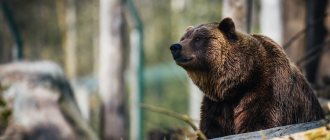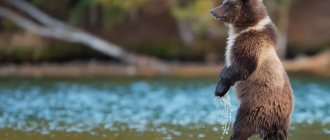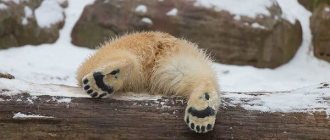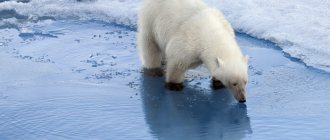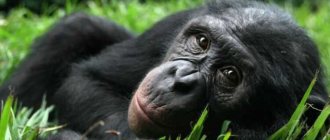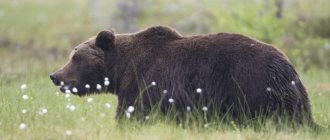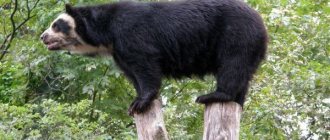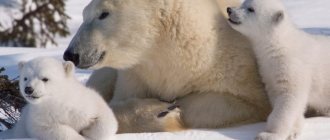Brown bears belong to the bear family, there are several subspecies of brown bears - grizzly, Kodiak, European and Siberian brown bear, as well as the Himalayan brown bear. Let's look at photos of brown bears and learn more about them.
Skeptics, when talking about unusual phenomena, argue that people confuse Bigfoot with the Himalayan brown bear. All representatives of brown bears are ferocious and dangerous predators, with whom other carnivores can hardly compete.
The Siberian brown bear is the master of the Russian taiga.
We will talk in detail about the Siberian and European bears. There are not many differences between these predators, so they can easily be considered as one Eurasian subspecies. There are currently about 200 thousand individuals in this subspecies.
Brown bear: general characteristics
Brown bears belong to the class of mammals and are considered the largest land predators. These animals simply amaze with their strength and power; they have a strong body with well-developed muscles, a massive head and thick, dense fur.
The real owner of the forest is the brown bear
Clubfoot predators prefer to settle in deciduous and coniferous forests, but some subspecies live in mountainous or swampy regions. Bears are practically omnivorous, and can eat both meat and plant foods, including herbs and grains. They do not disdain carrion, and often take prey from smaller predatory animals, such as wolves, pumas or coyotes.
In the wild, the average life expectancy of brown bears is 15-25 years. But in captivity they live much longer - from 30 to 40 years, although there are cases when these predators reached the honorable age of 50 years.
Depending on the variety, the height of adult bears ranges from 75-200 cm, and they weigh from 120 to 700 kg. These animals have pronounced sexual dimorphism, so females are always smaller than males.
Elena
Ask a Question
Question to the expert
Please tell me which bear is larger - brown or white?
The Arctic polar bear is larger and stronger than its brown relative. Adult polar bears weigh 400-500 kg, and the body weight of individual individuals can reach up to 800-1000 kg
Interesting facts about the animal
- Brown bears have well-developed hearing and sense of smell. They have poor vision.
- The animal is an excellent swimmer - in hot weather it swims about 6 km.
- When faced with danger, the bear begins to growl loudly, stands on its hind legs and tries to knock down the enemy or catch him with its front paws.
- Winter hibernation for bears can last from 75 to 195 days a year.
- If there is a sufficient food supply, brown bears living in the Caucasus or the Kuril Islands may not hibernate at all.
Natural habitat
Brown bears were once distributed throughout the European continent. They also lived in the northwestern countries of Africa, and also lived in most of Asia. But now the population of these animals has decreased significantly, and in some places they have completely disappeared. And the reason for this was, of course, people who not only displace bears from their natural environment, but also continue to actively hunt them.
Bears are now rare in the wild
At the moment, the habitat of brown bears is limited to the following regions:
- Russia (except for the southern regions);
- Western Europe: Pyrenees, as well as the mountain systems of the Alps and Apennines;
- Central part of Europe;
- Spruce forests of the Ukrainian and Romanian Carpathians;
- Northern European countries – Finland and Norway;
- Western Asia, Palestine, Iran and Iraq;
- Northern China and Korean Peninsula;
- Highlands of Tibet;
- Himalayas and Tien Shan Pass;
- Hokkaido Island in Japan;
- Alaska, Canada and USA.
Speed and agility are the distinctive qualities of the beast
At first glance, this huge animal seems very clumsy and slow. But that's not true. The big brown bear is very agile and easy to move. In pursuit of a victim, it can reach speeds of up to 60 km/h. The bear is also an excellent swimmer. He can easily cover a distance of 6-10 km on water and enjoys swimming on hot summer days.
Young bears quickly climb trees. With age, this ability dulls a little, but does not disappear. However, deep snow is a difficult test for them, since the bear moves through it with great difficulty.
Lifestyle and behavioral characteristics
Brown bears are solitary by nature; they never form permanent pairs and do not live in families. Each animal, be it a female or a male, has its own territory, which they protect from the encroachments of other predators and their own tribesmen. Bears mark the boundaries of their property with urine, feces and scratched or torn off bark on nearby trees. Intrusions of a stranger into the lands subject to the bear result in a fierce fight between two animals, in which often only one remains alive.
Bears vigilantly guard their territory
Males are very aggressive, but even they cannot compare in their anger to the mother bear who protects her cubs. Although females are smaller than male representatives, fear for the lives of their babies gives them unbridled rage, before which even strong, experienced males give in.
Despite their apparent clumsiness, bears are quite neat and quiet animals, and move almost silently. Of course, a frightened or enraged predator runs, breaking bushes and trees on its way, but in a calm state these animals will not betray their presence with a single unnecessary sound. By the way, the slowness of bears is also deceptive, because if necessary, they can run at a speed of 60 km per hour.
Skilled fishermen and maskers
Bears often feed on carrion. The clubfoot skillfully covers the found remains of animals with brushwood and tries to stay nearby until it completely eats its “find.” If the bear has recently eaten, it may wait a few days. After some time, the meat of the killed animal will become softer, and he will enjoy it with pleasure.
The most amazing activity of bears is fishing. They go to the Far Eastern spawning rivers, where salmon accumulate en masse. Bears and their offspring especially often hunt here. The mother skillfully catches salmon and takes it to her cubs.
Up to 30 bears can be seen on the river at the same time, and they often engage in battle for prey.
What does a brown bear eat?
The main secret of the survival of brown bears is their omnivorous nature. Clubfoot predators are never averse to eating meat, and do not miss the opportunity to hunt herbivores that are found in their habitats. A bear is capable of killing an elk or a wild boar with one blow of its paw, but often agile prey manages to escape from the clumsy beast. Therefore, despite all their strength and power, bears mainly have to be content with plant foods.
The bear found a whole field of lingonberries
Recommended by topic
Fox Panda Lynx
The brown bear menu includes:
- Roots and tubers of plants, cones, nuts, acorns, young shoots and stems of herbs, mushrooms;
- Berries: raspberries, strawberries, lingonberries, blackberries, blueberries;
- Small animals, for example, hares, chipmunks, gophers, mice;
- Amphibians and reptiles (frogs, lizards);
- All kinds of insects: ants, worms, butterflies, beetles, as well as their larvae;
- Wild boars, elk, deer, roe deer.
During salmon spawning, the bear fattens up to its heart's content on fatty fish. And of course, he cannot resist his favorite delicacy - honey, and always destroys the nests of wild bees that he comes across.
Bears love fish very much
During lean seasons, when there are few grasses and edible roots in the forests, brown bears raid farmers' fields, eating oats and corn. They can also kill livestock by dragging the carcass of a goat or sheep into the forest and feeding on it for 3-4 days.
Relationships with a person
The bear's most dangerous competitor in nature is humans. Just like for humans, a bear is a dangerous predator; meeting one can show how dangerous it is for humans.
Adults try to avoid meeting people and do not attack them without reason. The bear will not show aggression and will not return to the berry fields or appear on the banks of lakes and rivers if it notices people appearing there frequently. Even the lack of sufficient food supply does not provoke attacks on humans.
Tension may arise if the bear's habitat area is disturbed due to deforestation, or construction started in the bear's area of responsibility. Also, a female bear can show aggression if she notices contact between a person and a small bear cub.
Reproduction and mating season of brown bears
Growing up in brown bears occurs rather slowly, and they reach full maturity by 10-11 years of age. But these predators are ready to procreate from the age of 3, although many males have to wait another 1-2 years for the opportunity to mate with a female. And all because in the competition for the lady of their heart, young bears are inferior to more powerful and experienced adult males.
Bears fight for a female
For males, the mating season occurs every year, but females can bear cubs once every 2-3 years, so over the course of their lives, wild bears become mothers of approximately 4-5 offspring.
The rutting period for these animals occurs at the end of spring or beginning of summer, and can last several months. The females go into heat, and they leave scent marks everywhere, which serve as a signal to the males that they are ready to breed. During the mating season, males behave very aggressively, echoing the surroundings with an eerie roar, and fight among themselves for the right to possess the female. When fighting with an enemy, brown bears use their teeth and claws, which sometimes leads to the death of one of the opponents, who dies from his wounds.
The male must win the female
But the main battle of the victorious male is still ahead. After all, bears, like all representatives of beauty, can be capricious and picky. And the male is waiting for a new duel, this time with a female, in which he must prove to his chosen one that he is worthy to become the father of her future children. Of course, mating games between two individuals of the opposite sex are not as cruel as battles between two males. But even during them, a loud roar of animals is heard, and at the meeting place of a pair of bears, burned out scraps of fur and even bloody scraps of skin remain.
Males mate with only one female, and, having fulfilled their “marital duty,” return to their usual way of life, that is, searching for food before the long winter. But females are polygamous in this regard, and can have sexual intercourse with several males in one mating season.
Gestation period and development of cubs
Due to the fact that these animals hibernate in winter, the bearing of offspring in brown bears has its own characteristics.
Recommended by topic
Falcon Antelope Lynx
If a female becomes pregnant in the summer, the fertilized egg floats freely in the womb of the expectant mother, falling into a kind of suspended animation. Until the beginning of November, the female bear eats intensively in order to store a sufficient amount of fat, and also searches for and arranges a den. The female lines her shelter with scraps of moss, coniferous branches and dry leaves so that it is soft and comfortable for future babies.
As soon as the female bear goes into hibernation, the embryo “wakes up” and attaches to the wall of the uterus. After this, fetal development occurs at an accelerated pace, and after 6-8 weeks tiny babies are born. One female can give birth to from 1 to 3 cubs, in very rare cases there are up to 5 cubs in one litter.
In dry, hungry years, when there is not enough food in the forests, female bears do not have time to gain fat for the winter and prepare for childbirth, and then the fertilized embryo is simply absorbed by her body.
Adorable brown bear cubs
In general, the duration of pregnancy in brown bears lasts 6-8 months, and birth occurs at the end of February, beginning of March. And no matter how strange it may sound, females do not even wake up during childbirth, and even a week or two after it. So, from the first minutes of life, the cubs have to fight for their existence and look for nipples with nutritious milk themselves. And this is not easy for them, because bear cubs are born blind, deaf and tiny, their body length reaches only 23-25 cm and they weigh no more than 500 g. Nevertheless, babies on an intuitive level burrow into warm fur the mother finds her mammary glands by touch.
Question to the expert
Is the brown bear listed in the Red Book?
Yes, clubfoot predators are listed in the Red Book, but not in the category of endangered animals, but in the status of a “threatened species.” Some subspecies of these animals are indeed on the verge of extinction, but in general, the population of brown bears has not yet caused serious concern among zoologists.
Breeding period
Having regained strength after a long sleep, brown bears are ready to mate. The rut begins in the spring, in May, and lasts about a month. Females signal their readiness to mate with a special secretion that has a strong odor. Using these marks, males find their chosen ones and protect them from rivals.
Sometimes fierce fights arise between two bears for the female, in which the fate, and sometimes the life, of one of them is decided. If one of the males dies, the winner may even eat him.
During the mating season, bears are very dangerous. They make a wild roar and can attack a person.
Raising offspring
For two weeks, the main activity of newborn cubs is to sleep and get enough fat from their mother's milk. After this period, the cubs begin to hear, and after another 13-15 days their eyes open. Already in the third month of life, babies are completely covered with soft fur, and their milk teeth are erupting, thanks to which they can eat plant foods, but for another 1.5 years their mother will feed them with milk. The cubs grow quickly, their weight a few months after birth reaches 15-17 kg, in general, and they become full-fledged, although smaller copies of their parents.
Bears are very kind and caring mothers.
And only then does the female begin to breed her offspring into the wide world. Bears are extremely attentive and caring mothers. No matter how hungry the female is during hibernation, in the first days after leaving the den, she gives all the food she finds to the babies. Along the way, the mother bear teaches her cubs to dig up edible roots, find berries and cones, and catch insects and small animals.
The female also gives the cubs lessons in “social behavior.” After all, it is in childhood and adolescence that children develop their character and spirit of competition, which will allow them to survive when they begin an independent life. The fluffy cubs are very active and mobile: they play, push, and fight with each other. They are also distinguished by their curiosity, trying to climb every tree they come across and explore all the objects that come their way.
Mother bears are very patient with their babies, and steadfastly ignore their bites, scratches, tail and ear tugging. But even their condescension has a limit, and a particularly playful bear cub will receive a strong slap and a menacing roar, and the little naughty boy will remember such a painful lesson for a long time.
Bear nannies
Young cubs remain with the female until they are 2.5-3 years old, and during this period the female bear may have another offspring. And here the most interesting thing happens: sometimes children from the previous litter help the bear care for the newborn babies.
bear cubs climbing a tree
Zoologists have not yet been able to fully study this phenomenon. Some experts believe that only young females look after their brothers and sisters. Other experts agree that males become such “nannies,” although they were unable to support their version with evidence.
Bear family on a walk
Be that as it may, naturalists have encountered similar bear families more than once. And according to their observations, young animals from the past offspring really help the mother take care of the foolish babies. They even move in a certain way: the adult female is in front, the newborn cubs are behind her, and the more mature cubs bring up the rear.
Ursus arctos meridianalis
Mideastern Brown Bear.
Americans call it the Syrian brown bear. However, experts believe that the subspecies Ursus arctos siriacus (Syrian brown bear) lived in Syria and Lebanon, in the south of Israel, and today could survive in Turkey, Iran, and perhaps in the Caucasus countries. In the USSR it was distributed along the Black Sea coast of the Caucasus to the north to Abkhazia. This is the smallest subspecies of brown bear, whose fur is painted in dirty yellow tones. At the moment, the Syrian bear can only be found in some zoos in the world.
DESCRIPTION. The Caucasian bear is very variable in size, but smaller than the European one. Some zoologists distinguish two forms in the North Caucasus, which differ greatly in size - large and small Caucasian bears. Great Caucasian bear - Ursus arctos meridionalis - body length 180-210 cm or more, body weight 120 kg, and sometimes up to 240 kg, skull length of males - up to 394 mm. Small Caucasian - Ursus arctos caucasicus, respectively - 130-140 cm and up to 64 kg. These forms, judging by the available ecological observations, differ not only in morphological parameters, but also in biology. The small bear is characterized as an inhabitant of higher mountain regions and more vicious, while the large bear gravitates towards dense natural forests, although their cohabitation has been noted more than once. (A. M. Khatukhov, D. M. Taisaev)
The fur is short, coarse, and significantly paler in color than that of the Eurasian brown bear. The coat color ranges from pale straw to a uniform grayish-brown, with a large dark-colored patch of long hair at the withers. Sometimes with a rather wide dorsal stripe running from this spot along the entire back. A dark brown spot may also be on the head, which is sometimes also white. The claws are straighter and lighter in color than those of the northern subspecies.
SPREADING. Caucasus region of Russia. It also lives in Anatolia (the Asian part of Turkey), Iran, Georgia and Azerbaijan.
Hibernation of brown bears
Hibernation is one of the most important stages in the life of every brown bear. Indeed, during winter, such large predators simply have nothing to feed on, and nature itself took care of their survival, forcing the animals to spend a third of their lives in a state of sleep.
Bears living in the southern regions may not hibernate, although they also feed heavily in the summer, since in winter their diet is more meager and monotonous.
How a bear prepares for winter sleep
Preparation for hibernation in clubfooted animals begins at the end of summer, when forests and meadows are full of berries, mushrooms and edible plants. The bear intensively fattens its subcutaneous fat, eating everything it can find.
Before hibernation, the bear feeds intensively on any food
With the arrival of October, when the days become shorter and the nights become colder, the bear begins to look for suitable, and most importantly, safe shelter. Rock gorges and caves serve as their dens; these predators can dig holes or make depressions in a hole under a tree. The beast lines the bottom of its lair with moss and dry leaves so that it is dry, warm and cozy.
Period and duration of hibernation
The duration of hibernation lasts from several months to six months, and depends on weather conditions, as well as on the fact whether the bear managed to stock up on a sufficient amount of fat. Typically, clubfooted predators fall asleep in November-December and leave their wintering grounds in March-April.
Bear in his cozy winter den
During sleep, the metabolic processes in the bear's body slow down, the heart rate and breathing become more rare, which helps the animal save the fat resources it has accumulated with such difficulty.
Bear rod
Contrary to popular belief that you cannot wake up a hibernating bear even with a cannon salvo, these animals have light and shallow sleep. They may even wake up to look for a safer shelter, after which they fall asleep again.
Bear roar
But there are times when bears emerge from their sleep state in the middle of winter and begin to wander through the forest in search of food. Such animals are called “connecting rods,” and this happens if the animal did not have time to gain the fat necessary for the entire hibernation, and woke up from a feeling of hunger. Connecting bears are very aggressive; in search of food, they approach human dwellings and attack people without hesitation. Most of the predators that wake up ahead of schedule do not survive until spring, since they simply have nothing to feed on.
Lifestyle
The brown bear is a fickle animal. It feeds in one place, sleeps in another, and can move several kilometers away from its usual habitat to mate. A young bear wanders around the area until it starts a family.
The brown owner marks his domain. Only he can hunt here. He marks boundaries in a special way, tearing off the bark from trees. In areas without plantings, a bear can peel off objects that are in its field of vision - stones, slopes.
In summer, he can rest carelessly in open meadows, lying directly on the ground. The main thing is that this place is secluded and safe for the bear.
Enemies of brown bears in the wild
It would seem that how could the largest predators on earth really have enemies, since few animals would dare to attack such a huge beast. However, even bears cannot feel completely safe. After all, they share their natural habitat with other formidable predators, meeting with which often has dire consequences for them.
The Amur tiger is a dangerous enemy of the bear
One of these enemies for the brown bear is the Amur tiger. Striped cats try to avoid clashes with the clubfooted animal. But in some cases, battle cannot be avoided, for example, when these animals fight over prey. The bear is more powerful, but the tiger is more agile and fast, and if he manages to grab the scruff of his opponent’s neck, then such a maneuver decides the outcome of the entire battle. But tigers really rarely attack bears, and can only kill young animals or cubs, but they are too tough for adult animals.
Wolves hunt a bear as a whole pack
Bears can also become victims of wolves. Yes, a lone wolf will definitely not be able to cope with a brown animal, but we should not forget that gray predators hunt in packs, and the preponderance of forces is definitely on their side. True, wolves, like tigers, hunt mainly small bear cubs. But in winter, when they lack food, hungry animals out of despair can attack a bear that has not yet hibernated. And in such a fight, several wolves die, but the fate of the bear is also sealed.
Bears are each other's irreconcilable enemies.
But the main enemy of the brown bear is another bear. Among these animals, cannibalism is the norm, and strong individuals are not averse to feasting on their weaker relatives. If an adult animal meets a female with cubs, then without hesitation he will kill the still immature babies. And during the breeding season, fierce fights occur between bears, as a result of which one of the rivals may die.
Brown bears are amazing animals that embody courage, power and wild, primitive beauty. But for some people, the skin of this animal is only a valuable trophy that they can show off to their friends. The number of bears is still quite high, but if they continue to be hunted, there is a possibility that they will repeat the fate of many animals that have disappeared from the face of the planet. Aren't these amazing creatures worth preserving?
How to avoid meeting a bear
Make some noise
If you are traveling alone through the domain of a bear, and even more so along the river bank, where there is quite a lot of willow grass, let us know about you. Especially where terrain or vegetation makes visibility difficult. Make noise, sing, talk loudly, or tie a bell to your backpack. If possible, travel with a group. Groups make more noise and are easier for bears to recognize. Avoid dense bushes. If you can’t, then try to walk so that the wind blows from your back, and the bear can smell you. Contrary to popular belief, bears see much like humans, but they trust their noses more than their eyes or ears. Always let the bear know you are there.
Don't crowd the bears
Like people, bears use paths and roads. Don't pitch your tent near a trail they might be on. Go around those places where you smell dead fish, animals, or see animals feeding on carrion. There may be food for a bear there, and if it is nearby, it can aggressively defend the hiding place. As a rule, in such places the bear has a rookery - lying down.
Give the bear as much free space as possible. Some bears are more tolerant than others, but each has its own “personal space”—the distance within which it feels threatened. If you are in this area, the bear may react aggressively. When photographing animals, use telephoto lenses; getting close for close-up shots can put you in this danger zone.
Cleanliness is the key to health
Bears only have 7 months to accumulate fat before their long winter hibernation. Don't let them know that human food or garbage is easy pickings. It is foolish and dangerous to feed bears, or to leave food or garbage that attracts them.
Prepare food away from your tent. Store all products and food away from the camp. Hang food so that the bear cannot reach it. If there are no trees, store food in airtight or special containers. Remember that dogs and their food can also attract bears.
Keep the camp clean. Wash the dishes. Avoid strong smelling foods such as bacon or smoked fish. Don't let your clothes smell like food. Burn garbage on a fire, burn cans. Food and trash are equally attractive to bears, so handle them properly. Burying waste is a waste of time. Bears have a keen sense of smell and are good at digging.
If a bear approaches you while fishing, stop fishing. If there is a fish on the line, do not let it splash. If this is not possible, cut the line. If the bear realizes that he can get fish only by approaching the fisherman, he will return again. The bear may also mistake you for another bear - a stranger who is hunting (fishing) in its territory and react very aggressively.
Appearance of the Siberian "clubfoot"
The body of a Siberian bear grows up to two meters; these animals weigh from 400 to 800 kilograms, but this applies to males. But the females are slightly smaller - their weight reaches only 300 kilograms.
Our Siberian bear is one of the largest among its relatives. He has a rather muscular and powerful body, strong massive paws.
In Russia, the bear was credited with many human qualities, including the presence of a soul - only three animals were awarded this to the Russians: the bear, the cat and the dog.
The color of these taiga predators corresponds to their name - the fur is predominantly dark brown (brown), and on the legs it is even darker than on the rest of the body. Siberian browns grow large claws, their length sometimes reaches 8.5 centimeters! It’s unlikely that anyone would want to get acquainted with such a dangerous “manicure”!
Rohatina
First of all, I would like to clarify the very concept of “rohatina”. Most of us are sure that this is a stick with “two horns at the end.” Misconception! I’ll tell you where it came from a little later, but for now a few words about the “rohatina” itself. For bear hunting, two types of Russian slingshots and one type of native one are known - “Tunguska”, which is considered the most ancient.
The structure of the Tunguska spear is simple: a forged tip is put on a shaft - a “ratovishche”. The shaft is made of bird cherry or rowan. Its length is equal to the height of the hunter, and its thickness is no more than four and a half centimeters. For special strength, as well as to ensure that it does not slip in the hands, the frame is covered with strips of steamed birch bark.
Hunters call the tip of the spear a “feather” or “palm tree.” It is attached using hot resin to the thicker, butt part of the shaft. And on the lower end of the spear they put a wooden knob, which is called the “heel” or “thread”.
The size of the Tunguska “palm” very rarely exceeds two meters, while its Russian “sister” is much larger.
Russian staghorn is conventionally divided into “den” and “chase” hunting. The burrow spear is more massive. They use it to protect themselves from an attacking animal. And the slingshot for chasing is smaller and more convenient. It is needed when dogs attack a bear.
Our spear also differs from the Tunguska palm in the presence of a metal guard at the base of the tip. Hunters call the guard a “crossbar.” And here's attention! Instead of a forged guard, in the Middle Ages a crossbar made of horn was tied with leather straps. Hence the current name. In addition, to prevent the blood of the beast from flowing down the shaft of the spear, a horsehair plume was often attached below the crossbar.
Poorer hunters made the village rough with the help of simple transverse carvings. But the most chic thing in the old days was the gilded town hall with carvings on living wood. To do this, the bark was removed from the young trunk, a carving was made with a knife, and then the bark was wound back. The incised areas quickly swelled, forming intricate bumps and patterns. Later, the wood was cut down, polished, the pattern was completed, and only the finished town was covered with gold. It is clear that such a spear was the lot of only the rich and noble.
